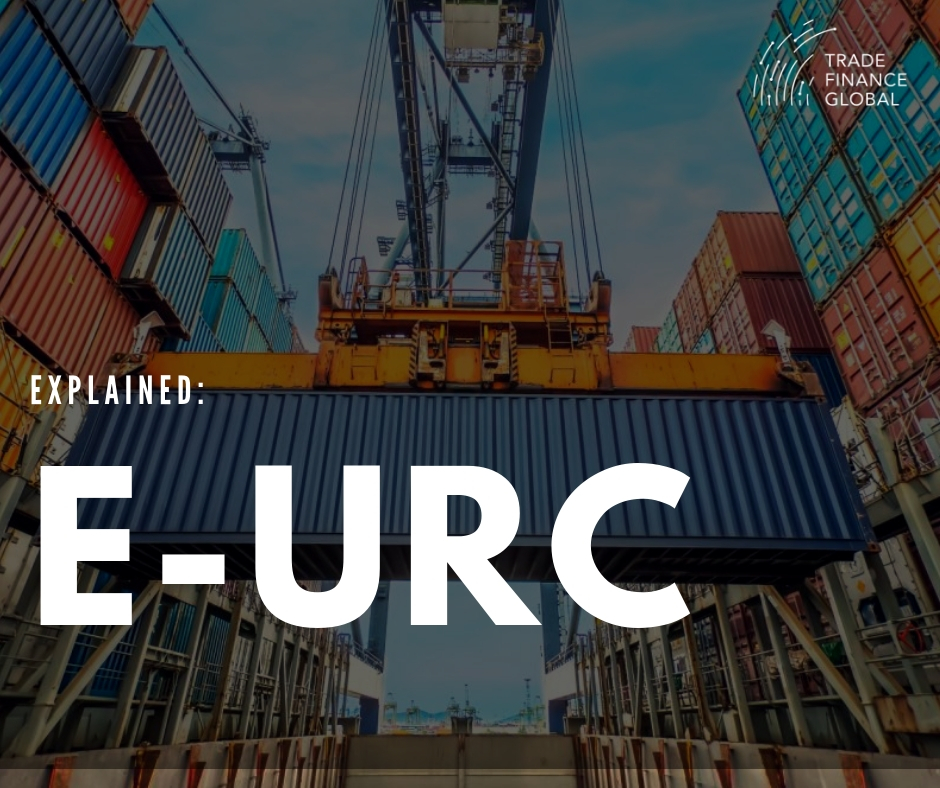The ICC Uniform Rules for Collections (URC522) Supplement for Electronic Presentation (eURC). On 1 July 2019, the revised internet eRules and guidelines for online trade finance documentary collections came into effect for banks, importers, exporters, and freight forwarders to prepare and present electronic records for documentary collections in lieu of or in conjunction with paper documents
Note: At the same time eUCP Version 2.0 for online trade finance documentary letters of credit was also published. Roughly 18% of world trade is done on eUCP 600 transactions (credits), and 18% on URC 522 transactions (collections).
ICC Commentary on eUCP Version 2.0 and eURC Version 1.0 … “It is inevitable that traditional trade instruments will, over time, inexorably move towards a mixed ecosystem of paper and digital, and ultimately, to electronic records alone. “

What is the URC 522 Uniform rules for Collections?
A “Collection” means the handling by banks of financial and/or commercial documents in order to obtain payment and/or acceptance or deliver documents against payment and/or acceptance.
“Financial documents” means bills of exchange, promissory notes and cheques used for obtaining money.
“Commercial documents” means invoices, transport documents, documents of title and the like.
“Clean collection” means collection of financial documents not accompanied by commercial documents.
The parties to a URC 522 collection are:
The “principal” who is the party entrusting the handling of a collection to a bank.
The “remitting bank” which is the bank to which the principal has entrusted the handling of a collection.
The “collecting bank” which is any bank, other than the remitting bank, involved in processing the collection.
The “presenting bank” which is the collecting bank making presentation to the drawee.
The “drawee” is the one to whom presentation is to be made in accordance with the collection instructions.
All documents sent for collection must be accompanied by a “Collection Instruction” giving complete and precise instructions in accordance with URC 522 rules.
The collection instructions must contain details of the bank from which the collection was received, and details of the principal, drawee, and presenting bank. They must also contain the amount and currency to be collected, a list of documents, and the terms and conditions of delivery of those documents.
Note. When negotiable documents under a UCP 600 documentary letter of credit are found not in compliance (discrepant), and the bank promise to pay is no longer valid, the transaction in essence defaults to a “collection”. The documents are usually sent on approval to the issuing bank for presentation to the applicant for payment.
What is the eURC Supplement for Electronic Presentation?
The International Chamber of Commerce Uniform Rules for Collections (URC522) Supplement for Electronic Presentation (eURC) Version 1.0
The eURC provides global trade practitioners the guidelines for using electronic records for URC 522 collections instead of or in conjunction with paper documents.
eURC Version 1.0 highlights:
- The eURC supplements URC 522 in order to accommodate presentation of electronic records alone or in combination with paper documents.
- The eURC shall apply where the collection instruction indicates that it is subject to the eURC (“eURC collection”).
- Document shall include an electronic record.
- Place for presentation means an electronic address.
- Sign and the like shall include an electronic signature.
- May be presented in any format (unless specified) by the collection instruction.
Remitting bank guidelines for issuing eURC collection instructions.
The eURC shall apply where the collection instruction indicates that it is subject to the eURC latest version. The collection instruction must indicate a place for the presentation of electronic records (email address and/or URL).
An eURC collection is also subject to URC 522 without express incorporation. However, the collection document requirements need to be taken into consideration in light of the supplement’s additional guidelines.
An eURC collection instruction must indicate the applicable version of the eURC. It must also indicate the electronic address for presentation to the collecting or presenting bank. It must also indicate the format for accepting electronic records, such as PDF and version number.
Drawee guidelines for eURC collection documents.
Each electronic record under an eURC collection must identify the eURC collection instruction. This would include the invoice, packing list, transport documents, certificates and the like.
An electronic record means data created, generated, sent, communicated, received or stored by electronic means, that is capable of being authenticated as to the apparent identity of a sender and the apparent source of the data contained in it.

An electronic signature, if required, means a data process attached to or logically associated with an electronic record and executed by a person in order to identify that person and to indicate that person’s authentication of the electronic record.
In practice, the electronic records (document) listed in an eURC collection can be a scan version (PDF) of the paper documents. Ink signatures and copies are simply not applicable.
eURC Impact on Trade Finance
The URC 522 collection process begins with the principal couriering his documents for collection to his remitting bank, who in turn forwards them by courier to the collecting bank with the collection instructions. The collecting bank may or may not be the presenting bank. The presenting bank obtains payment and/or acceptance from the exchange of documents with the drawee and sends the funds back up the chain to the principal’s remitting bank.
eURC electronic records and collection instructions could go directly to a presenting bank instead of bouncing around the globe between remitting, collecting and presenting banks.
Reducing and/or eliminating international bank trade finance service fees. Global trade flows are projected to reach US$24 trillion by 2026 generating revenues of US$48 billion to the international banking industry (2018 ICC Global Survey on Trade Finance). This revenue relies on technology from the past century; paper, brick and mortar, couriers and telex. Change the technology from paper to electronic records; from brick and mortar to the cloud; from couriers to attachments; and from telex to email, and the cost and time paradigm shifts from the banks to the trading partners. The end result could be collection payment time to exporters measured in hours and days instead of weeks. The multiple bank fees (remitting, collecting and presenting banks) could be reduced to only the presenting bank.
Conclusion
The present discussions about digital trade finance today are centered around seeking a global consensus for a universal digital technology and universal digital rules that 200 countries and 11,000 banks can agree too. These technologies include Bolero, essDocs, Voltron, Komgo, Marco Polo, CargoX, Trade Information Network, TradeLens, We.trade, and e-Trade Connect to name a few. These systems all have their various technical advantages. However, the eURC (and eUCP) already provide the universal digital rules needed; and it is not technology-dependent and could be used by these offerings immediately.
YES, eURC Version online documentary collections “could” be provided by your bank. The ICC has brought trade finance documentary collections to the Internet with eURC Version 1.0 for electronic records presentation in lieu of paper documents.
Everyone involved with global trade owes thanks and respect to the farsighted vision of Gary collyer, Dan Taylor, and James E. Byrne.


























